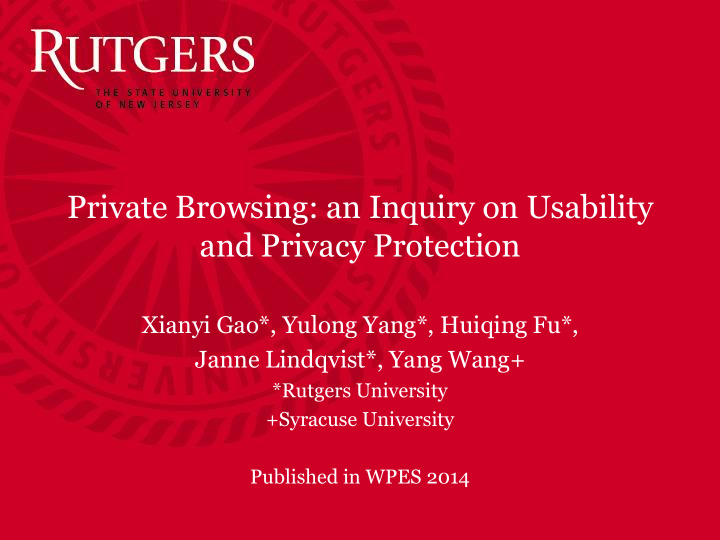



Private Browsing: an Inquiry on Usability and Privacy Protection Xianyi Gao*, Yulong Yang*, Huiqing Fu*, Janne Lindqvist*, Yang Wang+ *Rutgers University +Syracuse University Published in WPES 2014
What is private browsing? • Introduced in 2005 in Safari 2.0 • A feature in most current web browsers • Private browsing functionalities – Session browsing history is deleted – Cookies are deleted – Temporary files are deleted (differ in different browsers) • Sign-in password • Autofill information • Form data • Protect against local users sharing the computer 2
Motivation for user study • Previous research looked at how private browsing is implemented (USENIX Security’10) • No comprehensive user study on private browsing • Do users understand private browsing? • Any misconceptions? – Interpretation vs. Functionality – Potential privacy/security risk • User study provides feedback for developers 3
Private browsing mode in different browsers • Different browsers tested – IE 10 – Firefox 30 – Chrome 35 – Opera 22 – Safari 5 • Similar main functionality – Deleting browsing history and cookies • Difference in visual indicators • Difference in handling extensions • Difference in deleting temporary files – Autofill information, form data, passwords, download list entries 4
Private browsing in Safari 5
Incognito browsing in Google Chrome 6
Private browsing in Opera 7
Private browsing survey study • Amazon Mechanical Turk recruitment • 200 participants in US • Familiar with Internet browsing • 49% (N=98) females, 51% (N=102) males • Age distribution – Age 18-37: 68% – Age 38-57: 27.5% – Age 58-68: 4.5% • Various levels of education (from high school to graduate degree) 8
Survey responses grouping (most used browser) • IE: 8.5% participants • Firefox: 38% participants • Google Chrome: 48.5% participants • Opera: 1% participants • Safari: 4% participants 9
Awareness of private browsing • About 1/3 of 200 participants didn’t know about private browsing 10
Understanding of private browsing • Only browsing history was not saved (32.5%) – P3 said, “From the browsing history, future users cannot see what you used the internet for .” • Both browsing history and cookies were not saved ( 20.5% ) –P101 said, “Incognito browsing doesn't generate any browsing history or tracking cookies, it's as though you're using the browser for the first time every time you use it .” 11
Understanding of private browsing • Block websites and third party organizations from tracking personal online activity, completely anonymous browsing (20.5%) – “No personal data is collected by websites” – “It prevents other websites entering browsing history and tracking online activity ” – “All browsing history, cookies, cache get cleared, making browsing activity anonymous.” • Others ( 20.5% ) –“I guess the private mode is on, judging from the name.” – “Add -ons and scripts do not work on this feature.” 12
Understanding of private browsing (responses comparison across different browsers) 13
Reasons for using private browsing 14
Reasons for using private browsing (responses comparison across different browsers) 15
Websites visited in private browsing mode Responses from 81 participants: • No website preference: 28.4% • Preference on some particular sites: 71.6% • 49 different websites were listed in total 18 porn and dating sites 9 news and entertainment sites 7 social networking sites 6 finance and banking sites 4 online shopping sites 2 online workforce platform (Swagbucks and Amazon Mechanical Turk) 16
When did people use private browsing? Responses from 81 participants: • Morning before work: 21% • At work: 28.4% • At night after work: 39.5% • Late at night after 11pm: 28.4% • Other (no preference on time): 13.6% 17
Private browsing: benefits Responses from 81 participants: • Protect personal privacy (no browsing history saved): 59.3% • No cookies stored: 13.6% • Keep computer clean: 5% • Prevent malicious site’s attack (e.g. steal personal inform): 5% • Speed up webpage loading: 3.7% • Prevent virus attack & block ads online: 3.7% • No benefit: 5% • Not sure: 3.7% 18
Private browsing: drawbacks Responses from 81 participants: • No drawbacks: 46.9% • No browsing record when needed: 28.4% • Sign-in information not available: 8.6% • A mode without full browsing feature: 5% • Others: 11% – Some agencies can still track on personal online activities – No saving options available – Encourages secrecy and dishonesty in a relationship – Not sure 19
Conclusion • Findings – One third of participants were not aware of this privacy-enhancing feature. – For people who knew or even used this feature, they had various misconceptions which could put them at risk. – Private browsing users in Firefox and Chrome have similar responses about their perceptions on the private browsing. • Result implications – Better methods are needed for browsers to inform private browsing. – Emphasis about PB features should be provided to avoid misconceptions. 20
Questions? Thank You! 21
Recommend
More recommend